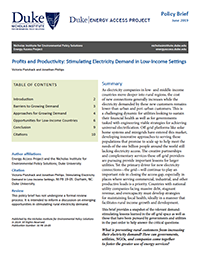As electricity companies in low- and middle-income countries move deeper into rural regions, the cost of new connections generally increases while the electricity demanded by these new customers remains lower than urban and peri-urban customers. This is a challenging dynamic for utilities looking to sustain their financial health as well as for governments tasked with engineering viable strategies for achieving universal electrification. Off-grid platforms like solar home systems and minigrids have entered this market, developing innovative approaches to serving these populations that promise to scale up to help meet the needs of the one billion people around the world still lacking electricity access. The creative partnerships and complementary services these off-grid providers are pursuing provide important lessons for larger utilities. Yet the primary driver for new electricity connections—the grid—will continue to play an important role in closing the access gap, especially in places where serving commercial, industrial, and other productive loads is a priority. Countries with national utility companies facing massive debt, stagnant revenue, and overcapacity must develop strategies for maintaining fiscal health, ideally in a manner that facilitates rural income growth and development.
This brief provides a snapshot of the relevant demand-stimulating lessons learned in the off-grid space as well as those that have been pursued by governments and utilities in the past order to help answer the critical questions:
What is preventing rural customers from increasing their electricity demand? How can governments, utilities, NGOs, and companies come together to foster the greater use of energy services?

